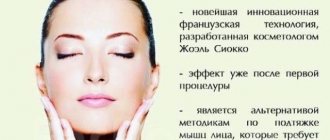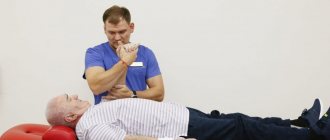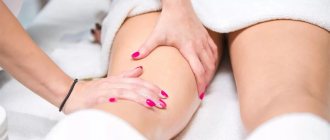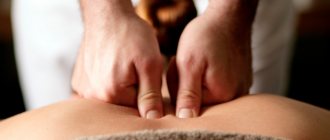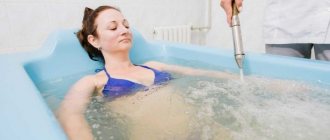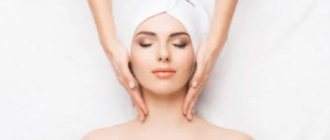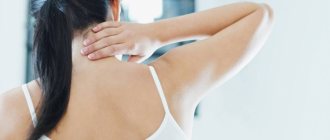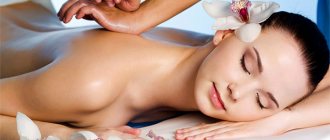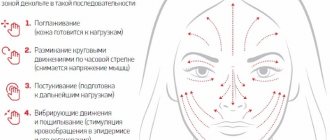Types of foot massage
There is a wide range of types and techniques of massage aimed at improving human health and well-being. Main types of lower limb massage:
- Classic massage
of the lower extremities is aimed at relieving leg fatigue, relaxing and improving muscle elasticity and joint mobility. - Anti-cellulite massage
is performed on areas prone to cellulite - legs and thighs. - Acupressure
involves influencing the bioactive points of the feet and legs in order to activate those processes in the body for which they are responsible. - Lymphatic drainage massage
is associated with the movement of lymph through the lymphatic vessels. Its purpose is to facilitate the outflow and improve the circulation of lymphatic fluid. - Vacuum
or cupping
massage
is aimed at increasing skin elasticity, reducing the appearance of cellulite, rehabilitation after plastic surgery, and eliminating stretch marks after childbirth. - Massage therapy
can include several types of techniques, the overall goal of which is to correct musculoskeletal disorders.
Preparing for a massage
For the procedure to be effective, you need to properly prepare for it. Massage is not performed on a full stomach . It is recommended to refrain from eating one hour before and after the procedure. If the patient wants to get rid of excess weight and cellulite, during the massage course you need to drink more water. This will speed up the removal of toxins from the body.
It is imperative to cleanse your body of sweat and impurities. Half an hour or an hour before the procedure, you need to take a shower with a hard washcloth or scrub.
The body should be relaxed, so you need to come to the salon for a massage session 15-20 minutes before it starts. This will give you the opportunity to rest a little and catch your breath after the journey.
It is also worth studying the list of what not to do before a massage :
- It is not recommended to use perfume or cologne immediately before the procedure . There should be no foreign odors in the office.
- Do not apply lotions or creams to your skin.
- You should not drink alcohol less than 24 hours before the procedure.
- You cannot smoke before a massage. A person may begin to cough while massaging the chest or back.
- You cannot hide the acute phase of a disease or inflammatory process from a specialist, so as not to miss a massage session.
The patient must honestly answer the massage therapist’s questions, report allergies to herbs and oils, and existing chronic diseases. If strange sensations occur during the procedure (burning, pain, numbness or tingling), you should immediately inform the specialist. Don’t be shy to tell the master about your feelings.
The therapeutic effect of lower limb massage.
Massaging the lower extremities has therapeutic effects:
• Improved blood circulation; • Improving lymph outflow; • Relieving muscle spasms and, as a result, eliminating pain from muscle tension; • Relaxation and relief from fatigue; • Stimulating tissue nutrition by improving the movement of blood and lymph; • Strengthening muscles and increasing muscle tone; • Relieving anxiety and improving well-being as a result of eliminating spasms and pain.
How does anti-cellulite massage work?
First of all, it is worth saying that the procedure is as individual as possible. The massage therapist works based on the specific characteristics of the patient: constitution (physique), problem areas, skin type, thickness and characteristics of the subcutaneous fat layer, and so on.
During the anti-cellulite massage, a carefully dosed load is applied to the skin and various levels of the subcutaneous layers. Thanks to special techniques, the result is not relaxation, as with conventional techniques, but, on the contrary, an increase in tone. Fat cells are broken down, and stagnant fluid is distributed among the cells of the upper layer of skin. This is the first stage of anti-cellulite massage.
During the second stage, the remains of split fat cells, waste and toxins are removed. The specialist directs them along the lymph flow, which carries harmful substances beyond the skin layers and then processes them.
At the final stage of the anti-cellulite massage, blood circulation is stimulated: this improves nutrition and breathing of the outer layers of the skin. As a result, cellulite is completely destroyed, muscle tone increases, and the skin in problem areas is noticeably rejuvenated. And all this is done in an absolutely natural way, by the forces of the body itself.
Stages of the procedure
Step-by-step procedure for lower limb massage:
1. The patient lies on his stomach or back. When lying on your back, place a cushion under your knees, while lying on your back - under your ankle joints. 2. Oil or cream of medium fat content is applied to the skin of the person being massaged. 3. The massage begins with light stroking movements that relieve muscle tension. Strokes are performed from bottom to top. 4. Then palmar rubbing is carried out. As the muscles warm up, shallow and light movements gradually intensify, becoming more intense and deeper. 5. Palm rubbing is replaced by kneading. The skin is grasped so that a fold is formed together with the adjacent muscles. 6. The next techniques are grasping squeezes and pushes with the heel of the palm, alternating with twists. 7. These techniques apply to all parts of the body. The foot area is warmed up using circular movements in a spiral. 8. Kneading and twisting alternate with vibration techniques. They begin with tapping with the edge of the palm. Next, grasping vibration is applied, when low-amplitude vibrations are given to the tissues being held. 9. The session ends with light strokes, starting from the toes up to the hips.
Classic massage technique
Traditionally, classical massage uses stroking, rubbing, kneading and vibration . First, the massage therapist gently warms the skin, stroking it, preparing it for the further procedure. Over time, the movements become more intense. Kneading increases muscle tone, improves posture and strengthens the muscle corset. Vibration strengthens blood vessels and also affects the deep subcutaneous layers.
Auxiliary techniques of classical massage include tapping and squeezing . Effleurage resembles vibration, but is performed with the knuckles. Such movements have a beneficial effect on the nervous system. Squeezing is similar to intense stroking. It has a lymphatic drainage effect.
There should be no unpleasant sensations during the massage. If the patient feels pain, he should report this to a specialist.
The classic massage technique has a number of features:
- The patient should be as relaxed as possible . Therefore, before the procedure, the specialist will prepare the room. The temperature should be comfortable.
- Both the patient's body and the massage therapist's hands must be clean . Before the massage, it is advisable to take a shower and use a scrub.
- Be sure to use creams or oils for massage . They make it easier for hands to glide over the skin, saturate it with nutrients, and increase elasticity.
- Movements during the procedure are divided into linear, zigzag, dash-shaped, and circular. A classic massage begins and ends with stroking .
Some massage therapists use incense and pleasant music to help the patient relax. To get a good result from a massage, you need to contact only experienced specialists who have undergone training.
The session takes from 40 to 90 minutes depending on the type of massage, its goals, the patient’s age and other features.
Massage directions for each part of the body
- Stroking and rubbing are performed only in the direction of movement of the lymph flow.
- Hands are massaged in the direction from the hands to the axillary lymph nodes.
- During abdominal , all movements should be made only clockwise.
- The neck should be stretched towards the collarbones, not towards the head.
- When massaging the legs , the specialist moves from the feet to the knee hollows and from the knee to the groin.
- The breast is massaged from the center to the axillary lymph nodes.
- The lower back should be kneaded very carefully, without strong pressure towards the groin area.
Indications
The choice of type and technique of massage depends on medical indications, which may include:
• Rehabilitation after injuries and in the postoperative period; • Correction of flat feet; • Paralysis and restrictions in movement after a stroke; • Joint diseases - arthritis and arthrosis; • Osteochondrosis of the lumbosacral region, complicated by radiculitis and inflammation of the sciatic nerve; • Increased physical activity; • Nervous stress; • Impaired motor functions of the legs; • Cellulite; • Excess body weight and metabolic disorders.
Structure of the lymphatic system
In terms of importance and complexity of the device, the lymphatic system is comparable to the circulatory system. Almost every cell of our body is connected to the mechanism for “transporting” lymph.
What route does the intercellular fluid with all its toxins and breakdown products have to take?
- Lymphatic capillaries.
Permeates almost the entire body. They absorb tissue fluid through their thin walls, and it flows into the lymph flow and becomes lymph. - Lymphatic vessels.
These are already larger channels into which multiple capillaries flow. The vessels are located approximately every half centimeter. - The lymph nodes.
Vessels lead to them, and here the lymph is cleared of harmful agents and enriched with antibodies. The nodes are located in groups in all parts of the body (except the back) and near important internal organs. Their location is in the area of the ears, lower jaw, collarbones, armpits, mammary glands, groin, knees, etc. - Lymphatic trunks and ducts.
Lymph enters them after passing through the “settlement” nodes. There are only 6 trunks and ducts in our body. They lead to the venous bed in the area of the collarbones, where lymph flows into the circulatory system.
Unlike the circulatory system, the lymphatic system is not closed, and it does not have its own “pump” organ like the heart. Lymph is driven by the work of our diaphragm (breathing) and muscle contraction.
Side effects
Undesirable consequences from massaging the lower extremities occur if precautions and contraindications are not observed. Such situations arise if massage procedures are resorted to without a doctor’s prescription or if they turn to an uncertified specialist. As a result of careless and unnecessary manipulations, damage to joints and ligaments may occur, as well as complication of an existing disease. For example, as a result of thrombophlebitis, blood clots can break off and travel through blood vessels, threatening to block blood vessels.
Modern types of lymphatic drainage massage
Lymphatic drainage massage can be performed using hands, salon devices and simple massagers.
- Manual massage.
It can be superficial (capillaries and small vessels are treated) or deep (the effect also affects the lymph nodes, fat cells are broken down). - Hardware massage.
Done in the salon. There are different types:- Vacuum.
A vacuum pump is used. The effect of vacuum can be combined with a laser (laser-vacuum massage) or a roller (vacuum-roller massage: the nozzle creates a vacuum, and the roller inside it additionally massages the area captured by the device). - Pressotherapy.
Special pants or boots are put on, which are inflated with air and compress the problem area. - Microcurrents.
The legs are lubricated with a special solution, electrodes are attached to them, which release a pulsed current. - Simple massagers.
Lymphatic drainage massage of the legs can be performed independently at home. Vacuum cans and a dry brush are best for this. They are simple and convenient to work with.Both the jar and the brush are good at removing excess water, removing stagnation, melting fat, activating blood circulation and metabolism, tightening the skin, fighting cellulite, stretch marks, and spider veins.
Due to the vacuum, the jar gives a deeper effect (the pressure difference in the tissues works), but the brush completely removes dead epidermal cells, triggering skin renewal.
The costs for such a massager are minimal and cannot be compared with expensive salon procedures.
A wonderful Beauty365 natural bristle brush (hard cactus or soft boar) or a set of Beauty365 rubber MIRACLE cans will cost less than 1 thousand rubles (if you get a promotion on the website www.beauty365.ru).
Features of the procedure
For some categories of patients, procedures require extreme caution and have their own characteristics.
Children's lower limb massage
Children's foot massage can begin at 1.5-2 months, but only according to the pediatrician's indications and should only be performed by a certified specialist. The procedures help correct some defects of the lower extremities: hip dysplasia, clubfoot, flat feet, hyper- and hypotonicity of the leg muscles.
Massage of the lower extremities during pregnancy
Pregnancy is not a contraindication for massage of the lower extremities. However, during this period there are a number of restrictions for the procedure: • I trimester of pregnancy; • Toxicosis; • Risk of miscarriage; • High blood pressure and edema; • Phlebeurysm; • Chronic diseases of internal organs; • Colds with high fever and inflammation of the lymph nodes.
Vibration and energetic techniques must not be used; sudden movements and electric massagers are prohibited.
Anti-cellulite abdominal massage
The massage therapist delicately and painlessly works the area around the navel and below. The following techniques are used:
- tingling;
- capturing skin folds and kneading them;
- rocking movements of the hands in the direction of the lymph flow;
- comb-like and circular rubbing;
- transverse and vertical kneading;
- kneading the lymph nodes in the diaphragm area;
- stimulation of the lymph nodes in the abdominal area.
An anti-cellulite massage session lasts 40-50 minutes. For maximum effect, you need a course of 10-15 procedures with a break of 1-2 days.
Absolute contraindications
- Diseases of the blood, heart, blood vessels: hemophilia, thrombosis, thrombophlebitis, aneurysm, heart valve defects, acute myocardial ischemia, severe sclerosis of cerebral vessels and some others.
- Renal, hepatic, pulmonary-heart failure.
- Serious mental illness.
- Pathologies of the lymphatic system.
- Diabetes.
- Active tuberculosis.
- Osteomyelitis (inflammation of the bone marrow).
- AIDS.
- Cancer, gangrene and other severe pathologies.
